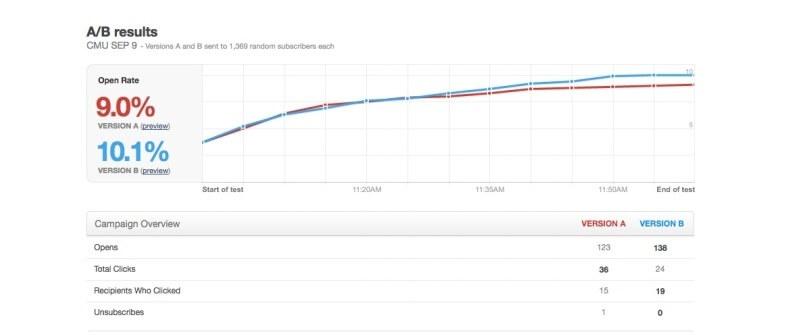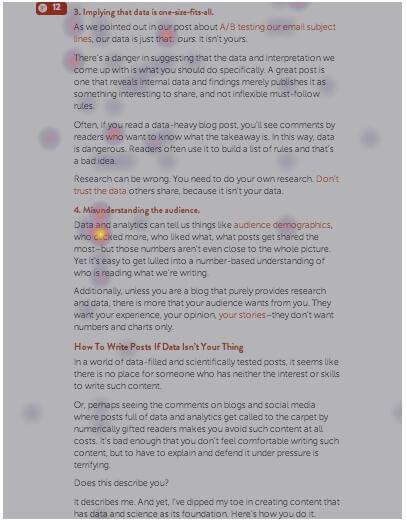3 Dead Simple Ways To Optimize Your Content
 You may be producing regular content as a way to drive traffic to your blog, but are you testing that content just like you would test any other landing page?
Content marketing—or using your blog as a tool for traffic growth—is a great way to encourage readers to visit your site, share your content with others, and hopefully become a verified lead that you can follow up with.
But this doesn’t happen automatically.
You need to make sure that your content creation process has a suitable content optimization layer. Just like the rest of your site and business.
You may be producing regular content as a way to drive traffic to your blog, but are you testing that content just like you would test any other landing page?
Content marketing—or using your blog as a tool for traffic growth—is a great way to encourage readers to visit your site, share your content with others, and hopefully become a verified lead that you can follow up with.
But this doesn’t happen automatically.
You need to make sure that your content creation process has a suitable content optimization layer. Just like the rest of your site and business.
 Here’s the key thought—you know that good optimization and A/B testing works on landing pages, home pages, and product pages, but are you properly testing things where your regular content lives? On your blog, for example?
With all of the knowledge out there about content optimization, it can be easy to apply the same scientific process to optimize your content marketing.
There are three simple methods you can use to optimize your content, and help you introduce an optimization layer to your blog.
The result?
More traffic, more shares, and more leads—it’s as simple as that.
Here’s the key thought—you know that good optimization and A/B testing works on landing pages, home pages, and product pages, but are you properly testing things where your regular content lives? On your blog, for example?
With all of the knowledge out there about content optimization, it can be easy to apply the same scientific process to optimize your content marketing.
There are three simple methods you can use to optimize your content, and help you introduce an optimization layer to your blog.
The result?
More traffic, more shares, and more leads—it’s as simple as that.
3 Ways To Optimize Your Content For More Traffic And Conversions
Click To TweetTip 1: Optimize Your Content To Get More Traffic
If you use a blog to create content and as a marketing tool, then one of your key metrics for success is the inbound traffic that comes in at the top of your funnel. While traffic isn’t the only metric that matters, it is an important place to start. It's also one of the areas that deserves some heavy content optimization. There are three primary sources of traffic that you can optimize.Source #1—social media
When new content goes live, you should be sharing it across all of your social media properties. Did you know that this process can be tested so that it will bring in more traffic? One of the ways to test this is to create a social sharing schedule that simply distributes your social messages more than once on each network. Share your content more than once on social media. You can see the different times we'll share this post on different social networks.
For this, you should be testing different times to post your content and different messages that may drive better results. We were able to double our own traffic with this process.
Share your content more than once on social media. You can see the different times we'll share this post on different social networks.
For this, you should be testing different times to post your content and different messages that may drive better results. We were able to double our own traffic with this process.
Use a #socialmedia sharing schedule to share your #contentmarketing at just the right time.
Click To TweetSource #2—email marketing
Most email marketing software makes it super easy to A/B test your email subject lines, or pretty much any of the content within the email itself. This is an important practice that is easy to implement. In fact, we never send out a major email that doesn’t have an A/B test built in. Always A/B test your email subject lines.
After A/B testing our own email subject lines for months, we’ve been able to draw several conclusions about how to make our audience more likely to consume and share our content.
The results for your audience will be different, but it is such an easy place to do testing, its's almost a no-brainer.
Always A/B test your email subject lines.
After A/B testing our own email subject lines for months, we’ve been able to draw several conclusions about how to make our audience more likely to consume and share our content.
The results for your audience will be different, but it is such an easy place to do testing, its's almost a no-brainer.
Source #3—SEO and SEM
Most of us are regularly optimizing our blog content based on keywords that potential customers and readers might search for on Google. This is a smart practice, and one that you can easily A/B test. What you need to do is narrow your content down to one or two different keywords or keyword phrases that you think your visitors are the most likely to use. From there, optimize your content accordingly and make a small AdWords campaign for each keyword phrase that you are testing. After you run the paid campaigns for a few weeks, you should get a clear picture of what keyword will bring the most click-throughs, and you can optimize your content according to that keyword. For more tips on A/B testing your SEO pages, check out this excellent guide on the Neil Patel blog.Optimize your current #blog content by #ABtesting with an AdWords campaign.
Click To TweetTip 2: Optimize Your Headlines To Get More Shares
After reaching a milestone of more than one million headlines in our database, our team started to wonder if we could find a way to predict how likely a headline was to be shared on social media. To our surprise, we found a little secret. Emotional headlines are in fact more likely to be shared via social media. With that in mind, we decided it was time to build a new tool to combine that data with everything else we know that makes up the best headlines. That's the Headline Analyzer Studio. Content with headlines scoring 70 or better with the Headline Analyzer Studio are some of the most likely to be shared.
This means that one of the best ways to get more shares is to write better headlines, and there are some easy ways to test those headlines as you learn.
Content with headlines scoring 70 or better with the Headline Analyzer Studio are some of the most likely to be shared.
This means that one of the best ways to get more shares is to write better headlines, and there are some easy ways to test those headlines as you learn.
A/B test your headlines.
Buffer, for example, has outlined their own process for A/B testing headlines on their blog. Their method is simple. By sending out a couple tweets with two alternate headlines, they are able to see which headline gets the most attention on Twitter. From there, they can adjust their post to accommodate the winning headline. Another option for A/B testing your headlines is by using the KingSumo Headlines WordPress Headline tool, which allows you to test multiple headlines at once. Over time, the tool will automatically select the best headline to use permanently going forward. It is a great ‘set it and forget it’ option. Write Better Headlines With Headline Analyzer Studio
The Headline Analyzer Studio will help you:
Write Better Headlines With Headline Analyzer Studio
The Headline Analyzer Studio will help you:
- Use headline types that get the most traction for social shares, traffic, and search engine ranking.
- Make sure you have the right word balance to write readable headlines that command attention.
- See the best word and character length for search engines like Google and email subject lines, while also seeing how your readers will scan your headlines.
Optimize your #headlines to increase your #socialmedia shares.
Click To TweetTip 3: Optimize Your Content To Get More Leads
So, you’ve optimized your content to get more traffic and more shares, but what are you doing with all of those new visitors? Hopefully, you're converting some of those visitors into leads. This is another area that begs for some efficient A/B testing.Test different lead collection methods.
There are several methods you can use to collect email leads, and even a few simple plugins that will help you with the process. But don’t take the default settings for granted. You need to test the methods for finding leads. For example, Noah Kagan recently shared his extensive pop-up box testing. He was able to determine the best time to display a pop-up box and learned exactly how often he could display it without annoying his readers. A few of the things that you should be A/B testing include:- The overall look and feel of your lead collection area. We were able to increase conversions by switching from a blue to an orange option form. A simple change with a big result.
- The copy and content displayed on your lead collection form. Can you increase conversions by adding social proof?
- How long a user needs to be on your page before seeing your lead collection form. Noah Kagan found the magic number to be 5 seconds.
- Various methods and locations for lead collection. For example, does a pop-up or slide-in lead collection form perform better?
Test different signup offers.
Another thing you can test is the offer you make visitors in exchange for signing up. For example, does offering them a valuable piece of content improve conversions? We found that by offering a free e-book or download, we were able to double our conversion rate over night.Test different signup offers to increase conversions #ABtesting
Click To TweetUnderstand how visitors use your page.
One of the most important aspects of lead collection is actually understanding how visitors interact with your page in the first place. Using a heat mapping tool, like this free one from SumoMe, you should be able to see a detailed view of how people actually interact with your content. Heat maps will help you understand how visitors read your content.
By using this on our own blog, we were able to determine that only 20-30% of our readers actually made it to the bottom of our post.
Heat maps will help you understand how visitors read your content.
By using this on our own blog, we were able to determine that only 20-30% of our readers actually made it to the bottom of our post.
For this reason, it made little sense to emphasize the lead collection form at the bottom of our page. Rather, we were able to add a lead collection form at the top of the page that significantly improved our conversion rate.


